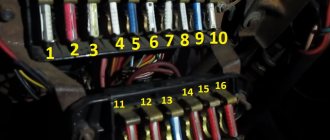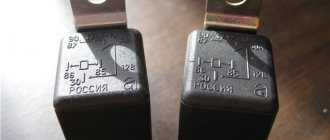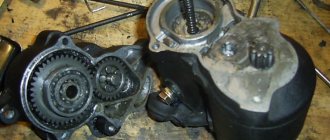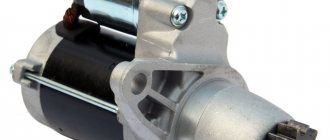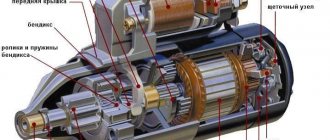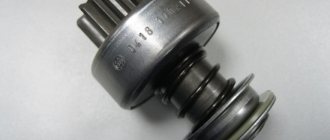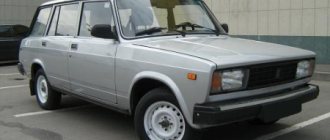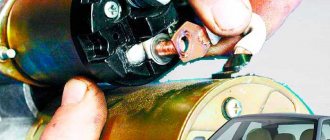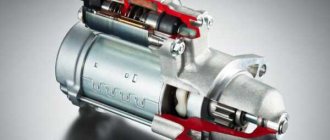If the car is after a trip, then before removing the starter on the VAZ, you should wait until all components and mechanisms have cooled down.
Regardless of whether a gear starter is installed on a VAZ 2106 or UAZ, the problems are similar. If the car does not start, the VAZ 2106 starter does not turn well, first check the quality of battery charging. In addition, you should check how well the terminals are secured. If everything is fine with the charging and terminals, then the cause of problems with starting the engine may be in the starter.
The following malfunctions of the VAZ 2106 starter are possible:
- The device turns on, but the traction relay does not work: the traction wire is broken, the tips are not tightened well, there is a short circuit in the traction windings or to ground, the contacts have oxidized, the retractor armature is stuck.
- After switching on, a click occurs, the traction relay works, but the armature does not function or it rotates too slowly, the starter does not turn: the fastening bolts on the retractor are not tightened well, the brushes are worn out or stuck, the commutator plates are short-circuited or are burned out, the windings are damaged.
- When starting, the relay clicks, the armature works, but the crankshaft does not rotate: the buffer spring is broken, the clutch slips, slips out of the axle, or the clutch engagement lever is broken.
- The starter does not turn off when the engine starts: the relay or drive lever is stuck, the contacts are stuck together, the mechanism is skewed, the ignition switch return spring is faulty.
- Increased noise during startup: the unit is poorly secured, the bushings are worn, the teeth on the gears are broken.
It is important to be able to quickly diagnose the problem and know how to deal with it. Below is a list of the most common car breakdowns.
If the starter does not click or turn, what should the owner of a VAZ-2106 do in such a situation?
There can be many reasons for this problem. The simplest and most common is a battery that is grounded to zero. Recognizing the source of the problem in this case is not difficult. You just need to turn on the headlights. If they do not light up, it means the battery is completely discharged. In this case, you can start it “from the pusher” or ask your neighbors in the garage for a “light.” By the way, the headlights can shine at full intensity. That is, the battery is not completely dead, but the starter does not have enough energy. In this case, the retractor, if everything is in order with it, will make itself felt with a click.
If the battery is charged normally, then you need to continue searching for the source of the problem. We check the integrity of the fuses. If everything is in order here, we look further. By the way, the fault may well be in the ignition switch itself. To check this version, you should carry out a simple manipulation. In particular, you need to try to start the car directly by connecting the necessary wires to each other. If after such manipulation the starter comes to life, it means that the problem is really in the lock, and it should be replaced.
However, before doing this, also check the ignition contact group - it is quite possible that a break has occurred there.
Next, carefully inspect the wiring for breaks. If everything is in order here, then we continue the search. The absence of clicks from the solenoid relay may indicate:
- contact between the rotor “mass” and the positive charge of the stator;
- jammed bushing or shaft of the electric motor.
Without removing the starter, it will not be possible to determine the exact cause. It is quite possible that the absence of clicks is due to the short circuit of the rotor or stator winding. To understand the reason, in any case, you will need to remove the starter and disassemble it.
After this, carefully inspect the retractor terminals. It is likely that they need cleaning (or replacement) after which the problem disappears. If this procedure does not help, check the relay winding. The presence of a malfunction will be indicated to you by a characteristic burning smell. The problem can also be caused by a loose fit between the brushes and the commutator, or too much wear on the commutator. It is quite possible that you just need to replace the retractor.
One point is worth noting - if you have already disassembled the starter, found a specific malfunction, and fixed it, then still conduct a visual inspection of the entire device. This kind of preventive maintenance is extremely useful in preventing future malfunctions. If you see that a part is clearly reaching the end of its service life, replace it immediately. This will eliminate the need to disassemble the starter again after some time. That is, in this case you are doing a kind of prevention.
In conclusion, I would like to note one more point. There are often situations when the retractor clicks, but the starter still does not start the engine. There are many more possible reasons here. However, it also happens that after turning the key there is no reaction at all. Let us list once again all the most typical causes of this problem, both with and without retractor clicks:
- discharged battery;
- loosening the tightening of the tips;
- mass short circuit;
- oxidation of terminals or terminals on the battery;
- brushes worn out or stuck;
- burnt out collector;
- slipping of the freewheel;
- damage to gear teeth;
- bushings that have exhausted their service life;
- egnition lock;
- relay malfunction.
Cause of malfunction
If the starter does not turn over hot, this may be due to various reasons.
When the starter turns tightly, while ensuring poor starting of the power unit, the problem may lie in the following:
- Battery discharge. If the battery has been in use for more than a year, it can discharge quite quickly, especially if the driver forgets to turn off the equipment after parking the car. Therefore, if starting a hot engine causes difficulties, the first thing you should pay attention to is the battery.
- The starter turns poorly when cold or hot as a result of wear on its brushes or bearings. If the brushes wear out, they will not be able to reach the commutator normally, and accordingly, starting the power unit may be difficult. If the bearings wear out, then as a result of heating the armature may come into contact with the stator, which subsequently leads to a short circuit. And this, in turn, reduces the speed of the unit.
- Poor engine starting when hot may be a consequence of incorrect selection of bearing devices as a result of mechanism repair. When bearings get hot, they can seize. The problem can be solved by unraveling and sanding the elements to the required size.
- In some cases, the starter turns poorly when hot due to the ignition switch. In this case, you should initially diagnose the contact group of the device. In order to reduce the likelihood of losses in the electrical circuit of the device, you can additionally install a second relay.
- The retractor relay of the structure has stopped working, this may be indicated by the absence of a click when turning the key in the lock. This element must be replaced, but in addition, it is necessary to diagnose the integrity of the wiring at the solenoid relay terminal. It would be a good idea to visually check the cable between this mechanism and the battery.
- If starting the engine is difficult, but the starter unit is operating normally, the problem may lie in the performance of the power unit. It happens that one of the crankshaft liners gets rubbed as a result of wear, so starting on a cold start is normal, but starting on a hot one is more difficult. This is due to the fact that the liner is clamped by the crankshaft when heated. In some cases, the reason lies in the axial displacement of the shaft itself, which is caused by wear of the axial displacement liners. One way or another, problems of this kind can be solved by repairing the power unit.
Car starter: main purpose
Sooner or later, every car owner, regardless of its make and model, has to face the problem that his vehicle refuses to start. The first thing, naturally, is to check the fuel level, battery charge, and electronics. If all this does not cause any complaints and doubts about serviceability, then most likely the problem is in the starter. After all, successful engine starting depends on it.
Currently, as a rule, relays 35.3708 with an end-mounted collector are installed on cars of this model.
However, on some copies of the VAZ 2106, starters made in Germany or Belarus may be installed, since they can be interchanged with starter 35.3708.
At an earlier time, approximately in the 70-80s, the ST-221 starter was also installed.
Crankshaft wear
The reason why the starter does not turn on a hot engine may also be the crankshaft bearings - liners. Due to wear, oil starvation, poor-quality assembly and increased longitudinal (axial) play of the crankshaft, the liners may wear unevenly, which will give them an “wrong” shape, especially as a result of scoring on the surface. As a result, when the engine cools down, gaps appear between the crankshaft bearing journals and the liners, which makes it easier to crank the engine. When it warms up, the presence of these defects, on the contrary, can lead to complete jamming of the engine. In any case, when operating a car, it is advisable to respond as quickly as possible to its seemingly random “whims”.
Starter solenoid relay
The design of the relay in the starter of a VAZ 2106 car is considered to be quite simple, and every even slightly enthusiastic motorist can easily disassemble and assemble it independently. However, removing and then reinstalling the solenoid relay turns out to be an impossible task for many. However, professionals can handle this without difficulty.
If you suspect that the solenoid relay in your car is broken, you should definitely check it. The relay in the VAZ 2106, as in other car models, works as an electromagnet. In order to check its serviceability, you need to close it with a metal object, for example, a screwdriver. If the starter starts to rotate, then the fault is indeed in the relay. If you hear clicks from the retractor relay, but the starter does not start to rotate, then you need to look for the breakdown in it itself.
Troubleshooting the starter
Removing and disassembling the starter is a fairly simple procedure. During its implementation, we strongly recommend that you pay attention to the following points:
- Be sure to make sure that the rotor and stator windings are completely intact. Otherwise, there is no point in disassembling the device, since it must be replaced;
- make sure that the electrical contacts are not dirty or oxidized;
- Check the level of wear on the graphite brushes of the electric motor. It is quite possible that replacing them will be enough for the starter to work normally;
- check the performance and level of wear of the bendix.
Repairing the starter yourself is carried out in the following sequence:
- We carry out troubleshooting of parts and find replacements for those that cannot be restored;
- We carefully clean all components of the electric motor from dirt, dust, insulation, grease, and crushed graphite. They must be perfectly clean so that the starter does not create any problems;
- we repair those parts that can be restored;
- Using an ammeter and a voltmeter, we check all components of the electrical circuit and wiring. The current should be more than 23 amperes, and the voltage should be no more than 9 volts. Otherwise, there is a risk of a hidden short circuit in the device;
- We definitely test the windings with a multimeter, after which we eliminate any damage. Before assembly, it is also advisable to dry the parts and coat them with varnish, which acts as an insulator;
- We check the condition of the overrunning clutch and Bendix gear. Over time, these parts wear out, which is why an extraneous grinding or loud squeaking noise may be heard while the starter is operating. If you find worn teeth on a gear, it is better to replace it immediately to avoid problems in the future.
In addition, it is important to carefully check the serviceability and integrity of the collector plates. If their wear exceeds standard values, it is better to completely replace this unit, since it cannot be repaired or restored. The last stage is assembling the starter, connecting it to the battery and fixing it with special bolts.
The VAZ-2106 car starter is a very reliable and durable device. It may not create problems for many years, but this requires periodic comprehensive maintenance work, replacing worn elements and removing contaminants.
Source
Starter relay repair
Repairing the starter relay seems to be a very troublesome and often hopeless task, so an easier option would be to simply buy a new one and replace it. This is due to the fact that, worrying about the reliability of their product, most manufacturers produce non-separable starter relays for both VAZ 2106 cars and other brands of cars. However, there are still models that are not difficult to disassemble and repair.
There are several main breakdowns that you may encounter while working with the starter relay of a VAZ 2106 car. The first is wear of the mechanical wire, the second is the burning of nickels, and the third is a short circuit. Each of these failures can be determined by disassembling the starter relay.
You can also use a special tester to check the serviceability of the starter relay, which does a good job of determining a short circuit in the circuit.
If, after disassembling this part, you find scratches or burrs on it, they need to be removed using sandpaper. Parts that have significant wear can be corrected using gaskets, but this does not always bring the desired result. Sometimes it will be more effective to replace them with new ones. Damaged insulation should also be replaced with a new one. Collectors with worn or loose plates cannot be repaired and must be replaced.
If there are noticeable breaks or damage to the thread, then it is worth cutting a new one or using so-called screws.
If there are faults in the excitation windings, you should disassemble the housing, remove the screws securing the tips and terminals. The coils must be thoroughly dried and impregnated with insulating varnish. Contacts that have oxidized must be cleaned, and those that have been welded must be replaced with new ones.
The bushings on the starter of a VAZ 2106 car are changed if they have significant wear or scuff marks are found on them. To determine the wear of these same bushings, you need to measure the roller clearance. If it is more than 0.2 mm, then the bushings are worn out and must be replaced.
Assembling the starter parts of a VAZ 2106 car is carried out in the reverse order to the one in which you disassembled it.
When carrying out all the above work, one should not forget about safety precautions and under no circumstances violate them.
A starter is an element of a vehicle - an electric motor that has 4 poles. He starts the engine in the car. As for the principle of its operation, it is based on the fact that it transmits the initial stroke to the engine crankshaft. Thanks to the 4 brushes of this device, the level of power and torque increases. Of course, if the starter is faulty, the engine cannot be started.
Features of mechanism diagnostics
Starter for VAZ 2106
The starting unit is checked using a tester. After turning on the device, the voltmeter reading should not be higher than 8V, and the current should not exceed 23A.
You can check the windings using a tester; if it lights up, it means there is a short circuit. To perform a visual inspection of the starting unit, it must be removed and cleaned of dirt (video author - Irina Kuzilova)
When disassembling the device, each part should be visually inspected. Scores and scratches can be removed using sandpaper. Broken and worn parts must be replaced. It is also necessary to replace the VAZ 2106 starter bushings if they are badly worn.
A faulty collector cannot be repaired; it is advisable to replace it. The height is checked on the brushes. More than 12 mm is considered optimal, otherwise the brushes must be replaced.
VAZ 2106 starter circuit
First, let's take a closer look at the VAZ 2106 starter circuit.
Deciphering the VAZ 2106 starter circuit:
- — drive side cover;
- — retaining ring;
- — restrictive ring;
- — drive gear;
- — overrunning clutch;
- - drive ring;
- — rubber plug;
- — drive lever;
- — relay anchor;
- — holding winding of the traction relay;
- — pull-in winding of the traction relay;
- — relay coupling bolt;
- — contact plate;
- — relay cover;
- — contact bolts;
- — collector;
- - brush;
- - armature shaft bushing;
- - cover on the collector side;
- — casing;
- — shunt coil of the stator winding;
- - frame;
- — stator pole fastening screw;
- - anchor;
- — armature winding;
- - intermediate ring.
VAZ 2106 starter connection diagram
Deciphering the VAZ 2106 starter connection diagram:
- — generator;
- - accumulator battery;
- — starter;
- ignition switch;
P1 - pull-in winding of the traction relay;
P2 - holding winding of the traction relay.
What if it’s not an electrician?
It often happens that the electrics are all in perfect condition, but the starter 2106 does not turn, or rather, its rotor rotates, but the movement is not transmitted to the engine crankshaft. In this case, you need to look for a breakdown not only in the above-mentioned retractor, but also in the bendix - a device by which rotational motion is transmitted from the rotor to the flywheel.
It consists of a gear and an overrunning clutch, all mounted on a metal sleeve with splines on the inside. Most often, the overrunning clutch, a mechanism that allows the flywheel to rotate in only one direction, becomes unusable.
Replacing the Bendix is not difficult, but you will need to completely disassemble the VAZ 2106 starter. To do this, you should have at least a small set of tools with you. And it’s good if such a nuisance happened during the warm (and not hot) season. In winter, you are unlikely to want to touch the starter on the road.
But there is one breakdown that will require removing the gearbox. There is a ring gear on the flywheel. Over time, a small section of the teeth on it wears off, which makes it impossible to start the engine - the starter turns very quickly, but the movement is not transmitted to the crankshaft and extraneous metallic sounds are heard (creaking, grinding).
VAZ 2106 starter does not start
What signs indicate that the starter needs to be repaired or is time to be replaced? Why does the starter sometimes not start?
These questions have their own answers:
- The relay functions without problems. However, the anchor does not respond or makes slow rotational movements. Solution ! As a rule, this is due to burning of the collector. It is also necessary to pay attention to the winding. It must be complete. It is also possible that the relay fastening elements are loose, there is a short circuit in the commutator, the brushes are stuck or have become completely unsuitable for further use. However, the reason may lie in a discharged battery.
- The starter responds, but the armature relays do not function. Solution ! Often the whole point is that the anchor is stuck. In this case, it is worth checking how the tips are fixed. Is there a short to ground and what is the condition of the wiring?
- The armature rotates, but problems arise with the crankshaft. Solution ! It's worth checking the buffer spring. Most likely it's broken. Some components of the coupling may be damaged.
- Powerful noises are heard. This is often the result of damaged bushings and gears.
- In turn, the starter turns, but does not start. You need to take a closer look at the return spring. The device may also be skewed. It is also possible that the relay and drive handle are jammed.
Wear of starter bushings
The starter armature rotates, supported by copper-graphite bushings, which are plain bearings. When starting the engine, the front bushing takes on the main load, so it wears out over time. The increased gap between the bushing and the armature shaft results in the armature being pressed against the stator during startup. This, firstly, makes it difficult to rotate, and, secondly, leads to an increase in the current in the windings. As a result, the winding insulation burns, which leads to complete inoperability of the starter.
how to install a start-stop button instead of the ignition switch here
It is better to replace starter bushings in a car service - often reamers are required to adjust their internal diameter. If the starter has a front cover, usually made of aluminum alloy, then, in the absence of skills, it can be split when pressing the bushing. To replace the front starter bushing without a housing, you will need to remove it from the gearbox housing. In addition to the listed faults, defective spare parts may be found during repairs. So, for example, it happens that a purchased new bendix has a gear, teeth or housing made “out of size”, as a result of which the bendix “slips” a little further and rests against the gearbox housing. But such incidents, fortunately, are rare.
This is interesting: Selection of Ngk spark plugs for a car
Replacing the VAZ 2106 starter
The most common reason why a six starter becomes faulty is the failure of the retractor relay with which it is equipped. That is why, when turning the key, the driver will hear a characteristic click. Consequently, the engine will not start in this case.
True, sometimes it is necessary to completely replace the starter. But first you need to dismantle the old starter. To do this, use the key to “thirteen”.
Replacing the starter consists of the following steps:
- We remove the battery.
- Then you need to find the fasteners.
- Then you need to unscrew the 2 bolts.
Unscrew the bolts
Then you should pull the starter and move it towards the right. So it will move away from its previous position and shift to the right side.
- Next, you need to lift the left side of the starter and turn it upside down. It is pulled up all the way.
- This element of the vehicle should be lifted until the wiring located at the rear of the starter becomes accessible and the wires can be removed.
- There are 2 wires at the back. One of them is fixed using a standard nut, which initially needs to be unscrewed.
- A simple plug serves as the second nut. It needs to be moved to the side. It can be dismantled without much effort.
- Once the starter is free, it can be easily removed.
Unscrew the power cable nut
As for installing a new starter, it is carried out in the reverse order. This procedure will not take much time. It is recommended that you perform these steps in a specific sequence.
In other words, you first need to connect the wires to the starter, and only then install it in its original place. At the same time, the price of a new starter for a six ranges from 2 to 4 thousand rubles. It all depends on the manufacturer and modification of the device itself.
Starter relay VAZ 2106
The structural structure, which has a VAZ 2106 starter solenoid relay, has a complex structure. At the same time, many drivers who more or less understand the details of the “six” can disassemble it with their own hands.
As for subsequent assembly, not every motorist can cope with this task. In this case, it is best to trust the professionals.
If you think the relay needs to be replaced but are not sure, it needs to be thoroughly inspected. It is noteworthy that the relay in the six functions similarly to other elements installed in various vehicle models. That is, it performs the functions of an electromagnet.
To check its condition, it is closed with a metal object. For example, you can use a screwdriver. If the starter begins to make rotational movements, then the starter relay will indeed need to be repaired. When clicks are heard from the retractor-type relay, but the starter rotates, then it is the latter that is broken.
Why does the starter relay stop working? There are several answers to this question. The problem may be due to outdated parts (the material deteriorates over time). The winding also . In this case, the reason may lie in the combustion of nickels , which are located in the internal part of the relay itself.
However, for a novice driver who has not previously done repairs, it is necessary to find out where the VAZ starter relay is located. If he does not want to waste his time and think about how to disassemble this part (by the way, there is a visual diagram of the relay, and you can buy all the spare parts yourself), then he can turn to professionals. They will not only disassemble this part, but will also connect the relay. In this case the price will be minimal.
Starter solenoid relay
If the starter is safely removed from under the hood, it must be cleaned. Contaminants are removed from it. As for oxidized contacts, they are processed using sandpaper.
Diagnostics of the starter solenoid relay:
- The starter is located near the battery. In this case, 2 electrical wires are prepared, which must be of sufficient length. Wires intended for “lighting” are ideal. They are equipped with so-called “crocodiles”.
- Initially, the positive terminal is connected to the battery (the corresponding output of the solenoid relay) via one electrical wire.
- Then the other wire is connected to the battery terminal, which has a negative value.
- Finally, you need to touch the free unoccupied end of the electrical wire with a negative value. This contact must take place with the starter housing. Further actions will depend on the results obtained.
If during the connection process the solenoid relay makes a quick and distinct click, then it is operating normally. When the part does not show any signs of “life,” the solenoid relay must be repaired or completely replaced.
Engine starting system problems. Slow starter rotation
According to the diagram, the starting system is a starter, to which two wires are connected. One originates from the battery positive, passes through the ignition switch and is connected to the corresponding contact on the starter housing. The second wire originates from the vehicle ground (negative) and is connected to the starter housing. A fuse is connected between the ignition switch and the starter contact. It protects the electrical circuit from possible short circuits.
During operation, all wire connections tend to oxidize or corrode. As a result, the contact disappears, and the starter begins to work with frequent interruptions: it turns slowly or does not always start. In this case, it is necessary to regularly clean the contacts from traces of corrosion and oxidation.
Procedure for cleaning contact connections:
- Disconnect the battery terminals and wires that connect to the starter.
- Clean the surfaces of the terminals and contacts with sandpaper.
- Treat cleaned areas with gasoline or alcohol solution.
- Apply lithol or graphite to the connections and connect all the wires back.
If there is a short circuit, a fuse is triggered, which will indicate a malfunction with a melted insert. First, find the short circuit, eliminate it and replace the fuse. All work may only be carried out with the battery terminal removed.

